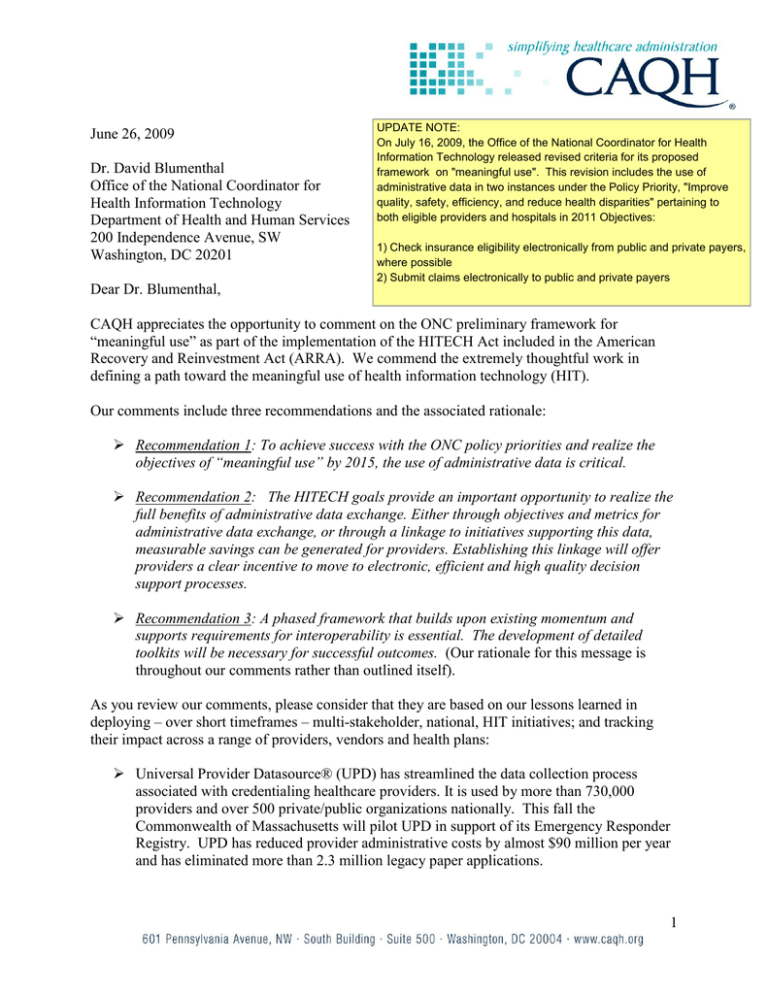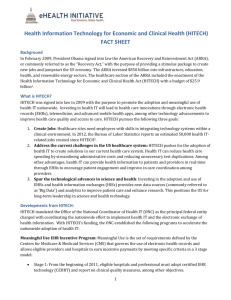June 26, 2009
advertisement

June 26, 2009 Dr. David Blumenthal Office of the National Coordinator for Health Information Technology Department of Health and Human Services 200 Independence Avenue, SW Washington, DC 20201 UPDATE NOTE: On July 16, 2009, the Office of the National Coordinator for Health Information Technology released revised criteria for its proposed framework on "meaningful use". This revision includes the use of administrative data in two instances under the Policy Priority, "Improve quality, safety, efficiency, and reduce health disparities" pertaining to both eligible providers and hospitals in 2011 Objectives: 1) Check insurance eligibility electronically from public and private payers, where possible 2) Submit claims electronically to public and private payers Dear Dr. Blumenthal, CAQH appreciates the opportunity to comment on the ONC preliminary framework for “meaningful use” as part of the implementation of the HITECH Act included in the American Recovery and Reinvestment Act (ARRA). We commend the extremely thoughtful work in defining a path toward the meaningful use of health information technology (HIT). Our comments include three recommendations and the associated rationale: Recommendation 1: To achieve success with the ONC policy priorities and realize the objectives of “meaningful use” by 2015, the use of administrative data is critical. Recommendation 2: The HITECH goals provide an important opportunity to realize the full benefits of administrative data exchange. Either through objectives and metrics for administrative data exchange, or through a linkage to initiatives supporting this data, measurable savings can be generated for providers. Establishing this linkage will offer providers a clear incentive to move to electronic, efficient and high quality decision support processes. Recommendation 3: A phased framework that builds upon existing momentum and supports requirements for interoperability is essential. The development of detailed toolkits will be necessary for successful outcomes. (Our rationale for this message is throughout our comments rather than outlined itself). As you review our comments, please consider that they are based on our lessons learned in deploying – over short timeframes – multi-stakeholder, national, HIT initiatives; and tracking their impact across a range of providers, vendors and health plans: Universal Provider Datasource® (UPD) has streamlined the data collection process associated with credentialing healthcare providers. It is used by more than 730,000 providers and over 500 private/public organizations nationally. This fall the Commonwealth of Massachusetts will pilot UPD in support of its Emergency Responder Registry. UPD has reduced provider administrative costs by almost $90 million per year and has eliminated more than 2.3 million legacy paper applications. 1 Committee on Operating Rules for Information Exchange® (CORE) has brought together over 100 organizations to implement the exchange of administrative data through a set of phased requirements. To quantify the impact of CORE, a study conducted by IBM tracked outcomes that impact over 33 million lives in different provider settings, including a wide range of vendor solutions. Results show that providers are saving millions of dollars due to increased efficiency and relying upon CORE-certified vendors to ensure the expected benefits. Moreover, these providers have increased their adoption of HIT by 33%, a critical indirect benefit. RATIONALE FOR RECOMMENDATION 1: ADMINISTRATIVE DATA IS CRITICAL TO REALIZING THE ONC POLICY PRIORITIES. ONC Policy Priority: Improving Quality, Safety, Efficiency, and Reducing Health Disparities. Of greatest importance is the focus on improving the quality, efficiency and safety of care delivered, and not on HIT. This deliberate approach is critical. The use of administrative data in the near- and medium term represents an essential and available migration path to the eventual marriage of clinical and administrative data, providing visibility and transparency into the cost-effectiveness of quality care delivery. Until clinical data becomes more readily available, robust, and easily exchanged, administrative data remains a key source of information with which to evaluate the quality of care and care delivery processes. In the long-term, as “meaningful use” evolves, administrative data will be required to understand the cost of specific treatment modalities and achieve the goal of a value-driven system. The importance of administrative data during this transition period was communicated by several experts who testified to NCVHS on “meaningful use”, including Dr. Carolyn Clancy, Director of the Agency for Healthcare Research and Quality (AHRQ). The capability for our system to fully produce and use wellintegrated, uniform administrative data has momentum, and this momentum should be encouraged. Many of the objectives in 2011, 2013, and 2015 will rely on the ability to collect and aggregate administrative data. Early-stage efforts can rely on standardized administrative data – such as ICD9/ICD10 and CPT codes – for first-order decision support. Based on existing standards, administrative data can be aggregated to support the near-term, population-level research priorities. The 2011 measures proposed focus largely on the match of patients with appropriate treatments – metrics that can be supported by administrative data. By 2013, ONC proposes to augment such measures with a focus on utilization. In this instance, administrative data provides a proven and mature foundation for aggregating data to measure utilization by service line, and site of service, to benchmark quality and efficiency. 2 ONC Policy Priority: Engaging Patients and Families. As our healthcare system begins to engage patients and their families, involving them in a more data-driven manner than ever before, it is critical that such engagement support patients in making informed decisions. In the near-term, administrative data is some of the most readily available for 2011 objectives; information that exists to help EHR and PHR adoption grow. In the longer term, integration of administrative and clinical data can allow consumers to more thoroughly understand their healthcare; preparing them to effectively engage in self-management regimens, provide feedback on care experience and ultimately help them evaluate information on the cost and quality of care provided by physicians, hospitals or other providers. This range of information is essential to a value-driven health system. ONC Policy Priority: Improving Care Coordination. Without interoperability, efforts to meet the HITECH objectives will fall short. To create the foundation required for better care coordination, administrative data interoperability needs to be linked to “meaningful use”. Ultimately, the objective of health information exchange (HIE) is the seamless transfer of all healthcare data. Administrative data exchange today serves as part of the foundation needed to promote such coordination and supports the HITSP transport efforts. For example, market adoption of the CORE transport has enabled one-to-one exchange between providers and payers across the country, providing a basis for one-tomany data exchange relationships. Beyond transport, administrative data is critical to care coordination. In a study by the eHealth Initiative, eligibility inquiries represent some of the high transaction volumes within HIE efforts focused on clinical data interchange.1 Following the lead of operational HIEs, ONC can clearly link meaningful use to transactions that support patient-provider administrative transactions, including but not limited to, eligibility, referrals and prior authorization. The more the “meaningful use” objectives incorporate current HIT Federal efforts and/or industry initiatives that have significant momentum, the greater potential HHS has in accomplishing the policy priorities. For example, the technical specifications gaining momentum in administrative data transport were designed to be aligned with the HITSP Specifications, and the administrative data being exchanged with this transport supports version 5010 of HIPAA. There are requirements that will no doubt receive key public and/or private industry messaging from now to 2013, so coordinating “meaningful use” with this messaging will allow for the greatest impact. ONC Policy Priority: Ensuring Adequate Privacy and Security Protections. We commend the emphasis that has been placed on the privacy and security of personal health information (PHI) as the industry migrates to electronic data exchange. Our lessons learned speak to the ONC objectives, especially those related to sensitive health information. In CORE discussions, sensitive data relating to women’s reproductive services, HIV/AIDS, 1 “Fifth Annual Survey of Health Information Exchange at the State and Local Levels: Overview of 2008 Findings,” eHealth Initiative, September 2008. 3 and mental health suggest that the industry is at an impasse, lacking consensus on if and how to adopt requirements for sensitive administrative data. The industry must treat clinical-administrative data for sensitive services within a common framework, and 2015 is too long to wait for such an approach. Providers and vendors need electronic access to the financial information related to such services. Given “meaningful use” will ask providers to exchange data in relation to metrics that are service-type specific and e-prescribing requirements do the same, the 2015 timing should be reconsidered. Moreover, there is great urgency to resolve the technical specifications for this challenge. Sensitive data exchange is already occurring and requires not just a legal framework, but a technical framework to ensure privacy and security. We urge ONC/ HHS to support efforts that provide tactical guidance, beyond the legal policies outlined by HIPAA. We are supportive, in particular, of the HITSP efforts to develop industry consensus on technical specifications for the secure exchange of both clinical and administrative data, and recommend that the Regional Extension Centers develop approaches to support this work. Pairing policy with actual tools will help the market achieve “meaningful use”. RATIONALE FOR RECOMMENDATION 2: ADMINISTRATIVE DATA EXCHANGE CAN HELP DRIVE HITECH GOALS. Providers have clearly communicated to CAQH that they will want to use HITECH resources to deliver “meaningful use” for clinical and administrative data exchange. Market Asks for Meaningful Use to Have an Integrated Framework. Individual states charting their own course for HIE, while also planning for HITECH, have indicated a strong interest in developing integrated administrative/clinical interoperability. Several state initiatives (TN, OH, NY, MA, etc) have contacted CAQH to discuss ways that administrative initiatives might be included in the definition of “meaningful use” in order to support their efforts, and have inquired as to whether CAQH could assist in making this recommendation. Other states that are already engaged in administrative data exchange efforts (OH, TX, CO, WI) have also raised this question. Such efforts should be encouraged in light of the downstream value of this integration to cost and quality reporting. Return on Investment (ROI)Is Needed During and After Access to Stimulus Dollars. Standardized administrative data exchange produces real and tangible return on investment (ROI). A 2009 CAQH-sponsored IBM study demonstrated the considerable benefits, potential savings and ROI results from adoption of such data. Results showed that such adoption leads to decreased claim denials and accounts receivable for providers. The CORE Phase I rules would save the system approximately $5 per transaction; which would translate into more than $3 billion in industry-wide savings over three years. The benefits of adoption are realized quickly, with stakeholders reaching ROI within one year. 4 Stimulus dollars alone will not cover the costs of realizing “meaningful use”. Administrative cost savings will help providers reach the benefits they need to embrace the bigger vision of transforming the system. Furthermore, as with clinical data, providers need a framework that outlines well-defined administrative data requirements from their vendors and plans. Helping Providers Manage Quality Reporting and Vendor Interoperability. The framework draft timeline is aggressive, leaving providers and their vendors a small window in which to adopt new requirements and to identify the patient populations and associated data elements needed to meet the reporting metrics. From the more than 140 million lives touched by the CORE participants, we have consistently heard about the challenges in managing vendor products. Even health systems that have adopted EHRs struggle with coupling partial automation with manual chart abstraction to aggregate quality performance metrics. We look forward to ONC efforts that will prioritize interoperability and streamline the quality reporting process. EHRs do not stand alone. Although there are many examples of integrated EHRs currently deployed, many EHRs are not designed to manage administrative data and few have addressed the necessary role of enabling exchange with practice management systems (or PHRs). We recommend that the technical roadmap established in the coming months specify the necessary capabilities to meet the interoperability objectives and quality metrics. We encourage ONC/HHS to develop resources that will support migration to the interoperability objectives. Such tools are vital for vendors and smaller providers. Should you have questions, please contact Gwendolyn Lohse, Deputy Director, at (202) 7781142 or glohse@caqh.org. We appreciate the opportunity to provide comments and look forward to working with you. Sincerely, Robin Thomashauer Executive Director 5



